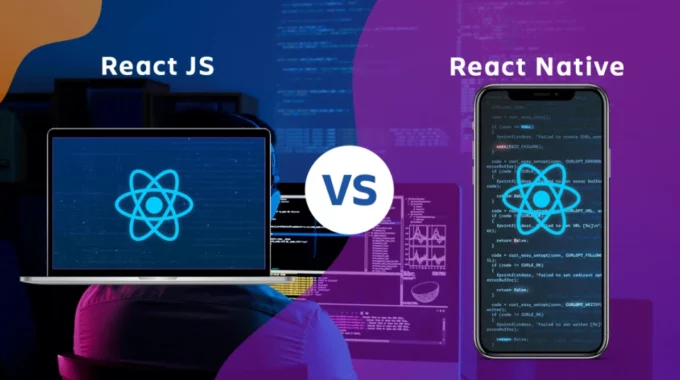A Javascript framework called React Native is used to create cross-platform apps that appear to be native on both Android and iOS. It makes it easier for developers to create cross-platform apps with a native feel using a powerful JavaScript library.
This technology, which is owned by Facebook, can be used to create user interfaces for mobile platform-based applications. Web development still has advantages that a firm can use for growth even though mobile apps are popular. Web apps have also promised growth prospects and improved consumer connections in comparison to mobile apps.
These are the most effective strategies to spread awareness of a company or product over the globe. This marked the framework's evolution as React Native. Two of the most potent technologies have emerged in the developer community.
Developers are forced to compare React Native Vs React JS and consider their utility and potential for creating web applications, mobile applications, mobile responsive websites, and more.
What is React js:
A JavaScript library called Reactjs supports both front-end and server applications. It can also be used to design user interfaces for websites and apps for mobile devices. Facebook created the open-source React.js framework and library for JavaScript.
It is used to quickly and efficiently construct interactive user interfaces and online apps in comparison to utilising pure JavaScript. It is especially made for creating apps for the Android and iOS operating systems.
Some of the advantages of Reactjs:-
Easy to Learn and Use
ReactJS is considerably simpler to use and learn. It contains a substantial amount of training resources, manuals, and guidelines.
Any developer with experience in JavaScript can quickly learn React and begin using it to build web applications. Although it lacks some features, it has the benefit of an open-source JavaScript User Interface (UI) library that makes it possible to carry out the task at hand more effectively.
Creating Dynamic Web Applications Becomes Easier
Due to the complicated scripting required, it was difficult to construct dynamic web applications using HTML strings, but React JS has made it simpler.
It offers more functionality with less coding. It makes use of the JavaScript Extension, a specific syntax that enables the rendering of specific subcomponents using HTML quotes and HTML tag syntax. Additionally, it facilitates the creation of machine-readable codes.
Reusable Components
Each of the various components that make up a ReactJS web application has its own logic and controls. These parts are in charge of producing a brief, reusable chunk of HTML code that you may use anywhere you need it.
The apps are easier to create and maintain because to the reused code. Since these components can nest with other components, simple building blocks can be used to create complicated applications.
To fill the HTML DOM with data, React Native Vs React JS uses a virtual DOM-based technique. The virtual DOM operates quickly because it just modifies certain DOM elements rather than rebuilding the entire DOM each time.
Performance Enhancement
Performance is enhanced with React Native Vs React JS to virtual DOM. A programming API that works with HTML, XML, or XHTML is called the DOM.
When the DOM was upgraded, the majority of developers encountered a bug that caused the application's performance to suffer. ReactJS introduced virtual DOM to address this issue. The React Virtual DOM is a representation of the DOM found in web browsers and exists entirely in memory.
The Support of Handy Tools
Another factor contributing to React JS's popularity is the availability of a useful collection of tools. The duty of the developers is made easier and more understandable by these tools.
You can examine the React component hierarchies in the virtual DOM by using the React Developer Tools, which are built as Chrome and Firefox dev extensions. Additionally, you can choose specific components, review, and update their existing states and properties.
Known to be SEO Friendly
Traditional JavaScript frameworks struggle to handle SEO. Applications with a lot of JavaScript generally have issues being indexed by search engines. Web developers have voiced numerous complaints about this issue.
React Native Vs React JS solves this issue, making it easier for developers to be found on different search engines. The virtual DOM will be rendering and returning to the browser as a typical web page as a result of React.js applications being able to operate on the server.
The Benefit of Having JavaScript Library
The majority of web developers favour ReactJS. It does so because a highly comprehensive JavaScript library is available. Web developers have more freedom to utilise JavaScript wherever they see fit thanks to the JavaScript library.
Some disadvantage of ReactJS
The high pace of development
Due to the environment changing so frequently, some engineers might not feel comfortable routinely relearning the new ways of doing things in the event of a downside. With all the ongoing upgrades, it could be challenging for them to adapt all these changes.
Poor Documentation
It is another another drawback of continually evolving technology. Because of how quickly React technologies are developing and accelerating, timely documentation cannot be produced.
With the development of new releases and tools in their existing projects, developers write instructions on their own to get around this.
View Part
ReactJS just covers the UI Layers of the application. Therefore, in order to obtain a full set of development tools for the project, we still need to select a few other technologies.
JSX as a barrier
Uses JSX is ReactJS. It is a syntactic addition that allows HTML and JavaScript to coexist. Although this method has advantages of its own, some members of the development community see JSX as a barrier, particularly for beginning developers. Developers bemoan the steep learning curve's complexity.
What is React Native:
For mobile apps, React Native is fantastic. The user interface is slick, fluid, and responsive, and load times are dramatically reduced.
React Native allows developers to create apps far more quickly and affordably than they could with native development, all without sacrificing functionality or quality.
React Native Vs React JS is a cross-platform mobile framework that is used to create apps and webpages called React Native. The ability to create mobile applications in JavaScript that can operate on various platforms, including Windows, Android, and iOS, thanks to React Native.
Some of the advantages of React Native
React Native is Community-driven
As a result of the developer community's demand for a mobile alternative that would combine the benefits of developing mobile apps with the strength and agility of the native React environment, the React Native framework was initially developed as a hackathon project.
React Native, a framework developed by Facebook and backed and continually advanced by the development community, is the consequence of this.
Using such a community-driven environment has several benefits, such as the availability of a sizable team of enthusiastic native and JS developers willing to contribute their knowledge and skills and sizable collections of freely available components.
Maximum code reuse & cost saving
We may deploy the same code to Android and iOS simultaneously by utilising React Native. This results in significant cost and time savings for development.
In actuality, the cost savings will be a little less significant, but they will still be more than compelling enough to justify the expenditure. Recent calculations show that 90% of the code between Android and iOS may be reused, but it would be prudent to factor in some extra time for useful updates as well.
Live reload
React Native, which expands on React's concepts and enables you to develop potent mobile applications, could be thought of as the mobile equivalent of React.
In fact, React Native includes a useful bonus that won't find in native frameworks the live reload feature, which lets you view the outcome of the most recent change we've made to the code right away.
If we have two windows open, one of which contains the code and the other of which, as a result of the code, displays a mobile screen,
Strong performance for mobile environments
The React Native architecture has been specifically designed for mobile platforms. Instead of relying heavily on the CPU like native platforms do, it uses the Graphics Processing Unit.
React Native Vs React JS is extremely quick when compared to hybrid technologies and the sole cross-platform choice in the past.
Modular and intuitive architecture similar to React
It is quite simple for other developers to dive into someone else's project and expand upon it because to the modular and user-friendly interface.
This boosts a development team's flexibility and makes it simpler to build updates and upgrades for web apps. Additionally, it will take testers less time to comprehend programming logic and create suitable testing scenarios.
Some of the disadvantages of React Native:
Lack of native libraries
The lack of native libraries and dependency on external, third-party libraries can cause React Native to sluggishly construct apps with significant functionality.
Swift, Objective-C, and Java are found to be faster than JavaScript when doing multiple complex calculations at once because JavaScript has overheads for managing native elements.
Loosely held abstraction layer
Javascript code, HTML tags, and CSS stylesheets are all accessible to programmers through the decentralised platform known as React Native.
Although it appears to be a good thing because it allows developers more freedom, there are drawbacks. For example, it imposes no parameters or restrictions, unlike Swift and Java, so practically speaking, a variable can be anything at any given time. This is unlikely to lead to a clash of logic when using Swift or Java.
Takes more time to initialize
The problem with React Native is that initialising the runtime for gadgets and devices takes longer. The main cause is the lengthy initialization time of the JavaScript thread.
Requires a lot of native workarounds
Developers have two options if a certain feature isn't available in React Native: either design native modules in Swift/Objective-C and Java themselves, or commission one from another native programmer. In other words, React Native adds overhead in terms of both costs and time.
Some of the differences between Reactjs and React Native:
Although React Native Vs React JS share many similarities, they also differ in some important ways.
- Reactjs is a base derivative of React DOM for the web platform, but React Native is a base derivative in and of itself. As a result, the syntax and workflow are maintained but the components change in React Native.
- In the end, Reactjs is a JavaScript toolkit that allows programmers to design attractive and effective UI Layers, whereas React Native is a complete framework for developing cross-platform apps for the web, iOS, and Android.
- React Native uses native APIs to render components on mobile devices, while Reactjs uses virtual DOM to render browser code.
- Reactjs programmes render HTML in the user interface, but React Native apps use JSX, which is essentially Javascript, to render the user interface.
- In Reactjs, styling is created using CSS, however in React Native, styling is created using a stylesheet.
- Similar to web development, animation in Reactjs is possible via CSS, however in React Native, motion is induced across many React Native application components utilising an animated API.
- Reactjs is the greatest choice when it comes to creating a high-performing, dynamic, and responsive user interface for web interfaces.
Conclusion:
React Native Vs React JS are key pillars for both app and web development, and they are both gaining ground steadily because to their adaptable functionality and expanding ecosystem of libraries.
Despite the fact that Reactjs is just a JavaScript library and React Native is the entire framework, the two complement one another because the former serves as the foundation for the latter.
React Native is perfect for giving the mobile apps a native feel, just as Reactjs is ideal for building apps with high functionality and complicated calculations.





